3 strong M-class solar flares erupt from Region 2567, CME produced
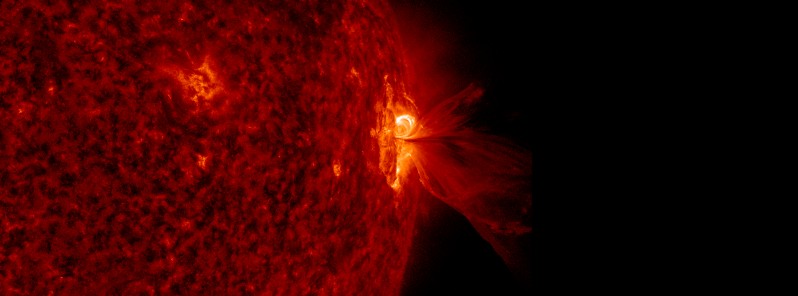
Three strong solar flares erupted from Active Region 2567 early on July 23, 2016 – M5.0, M7.6, and M5.5. A Coronal Mass Ejection (CME) was produced during the third one, however, this region is not in a position to produce Earth-directed CMEs.
The first flare started at 01:46 UTC, peaked at 02:11 as M5.0 and ended at 02:23 UTC. There were no radio signatures associated with this event that would indicate a CME was produced.
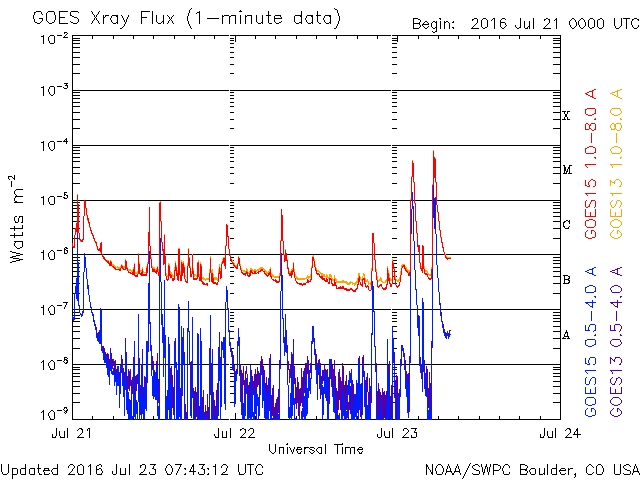
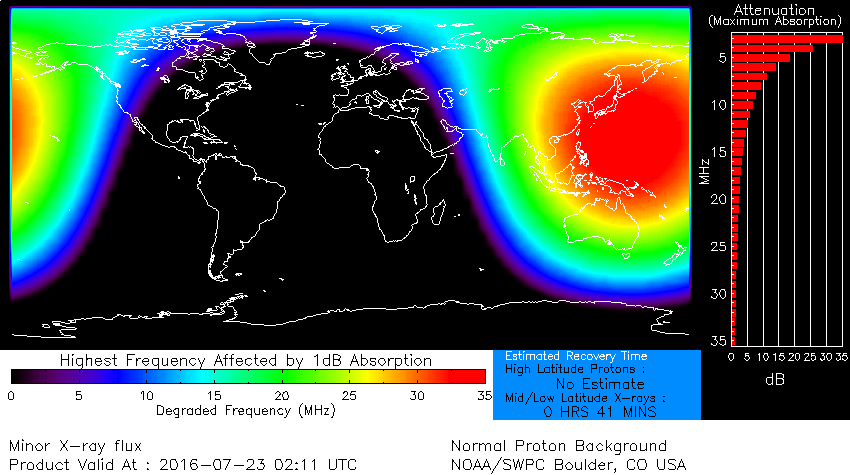
D-RAP at 02:11 UTC on July 23 – M5.0 solar flare peak. Credit: NOAA/SWPC
The second flare started at 05:00 UTC, peaked at 05:16 as M7.6 and ended at 05:24 UTC. A 10cm Radio Burst was associated (310 sfu) with this event.
A 10cm radio burst indicates that the electromagnetic burst associated with a solar flare at the 10cm wavelength was double or greater than the initial 10cm radio background. This can be indicative of significant radio noise in association with a solar flare. This noise is generally short-lived but can cause interference for sensitive receivers including radar, GPS, and satellite communications.
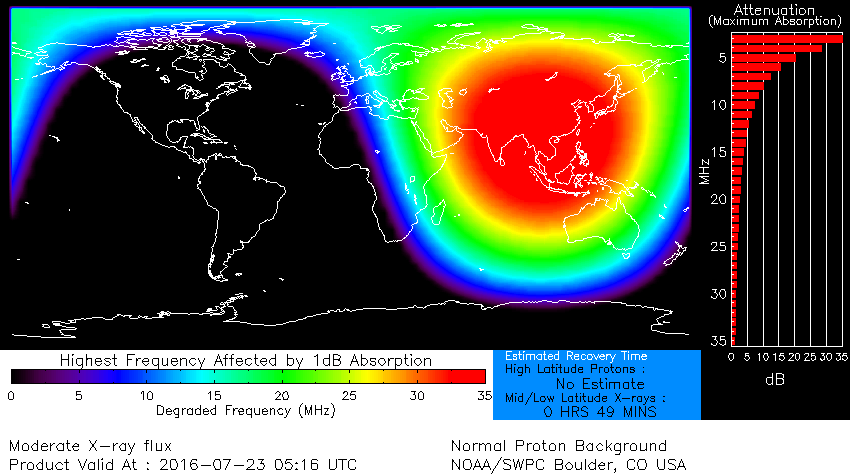
D-RAP at 05:16 UTC on July 23 – M7-6 solar flare peak. Credit: NOAA/SWPC
The third flare started at 05:27, peaked at 05:31 UTC as M5.5 and ended at 05:33 UTC. A Type II (estimated velocity 729 km/s) and IV radio emissions were associated with this last event. Type IV emissions occur in association with major eruptions on the Sun and are typically associated with strong CMEs and solar radiation storms.
Additionally, a 10cm Radio Burst (900 sfu) was registered between 05:27 and 05:30 UTC.
See the CME being produced in the video below:

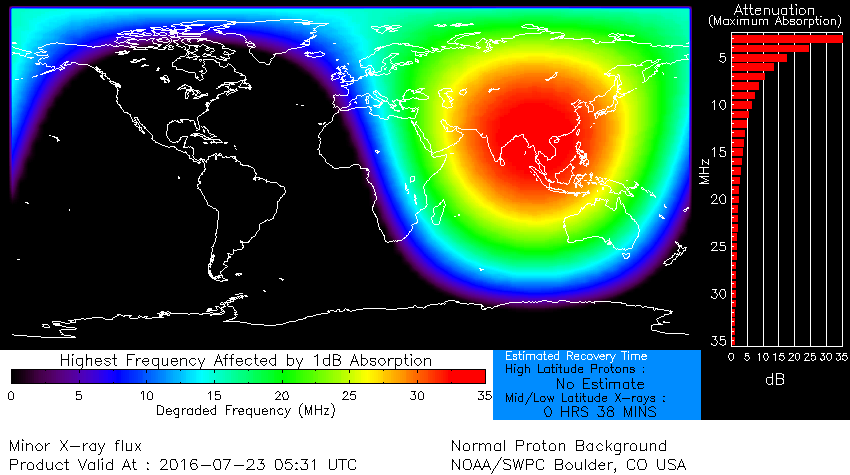

D-RAP at 05:31 UTC on July 23 – M5.5 solar flare peak. Credit: NOAA/SWPC
Initial coronagraph imagery observed a CME lifting off the west limb at 05:24 UTC. However, further coronagraph imagery is required to determine any possible Earth-directed component from this CME, SWPC said.
Credit: ESA/NASA SOHO / LASCO C2
There were 2 more interesting events over the past 30 hours.
A CME from the W limb was observed in LASCO C2 imagery, first seen 02:48 UTC on July 22. Analysis indicated the event source was probably at or just beyond the W limb. WSA-Enlil modeling of the event showed a clear miss to the west of the Sun-Earth line.
An approximately 20 degree long filament centered near N22E58 disappeared from the disk between 07:48 to 09:44 UTC on July 22. A faint, narrow CME was observed off the NE limb likely associated with this event beginning at 11:36 UTC July 22 in C2 imagery. This event is not expected to be geoeffective.
Sunspots
There are currently 2 numbered sunspot regions on the Earth side of the Sun. Both regions are showing slight decay in their northern area of leader spots. They will start their farside rotation on July 25.
Old region 2561 is due to return over the next two days.
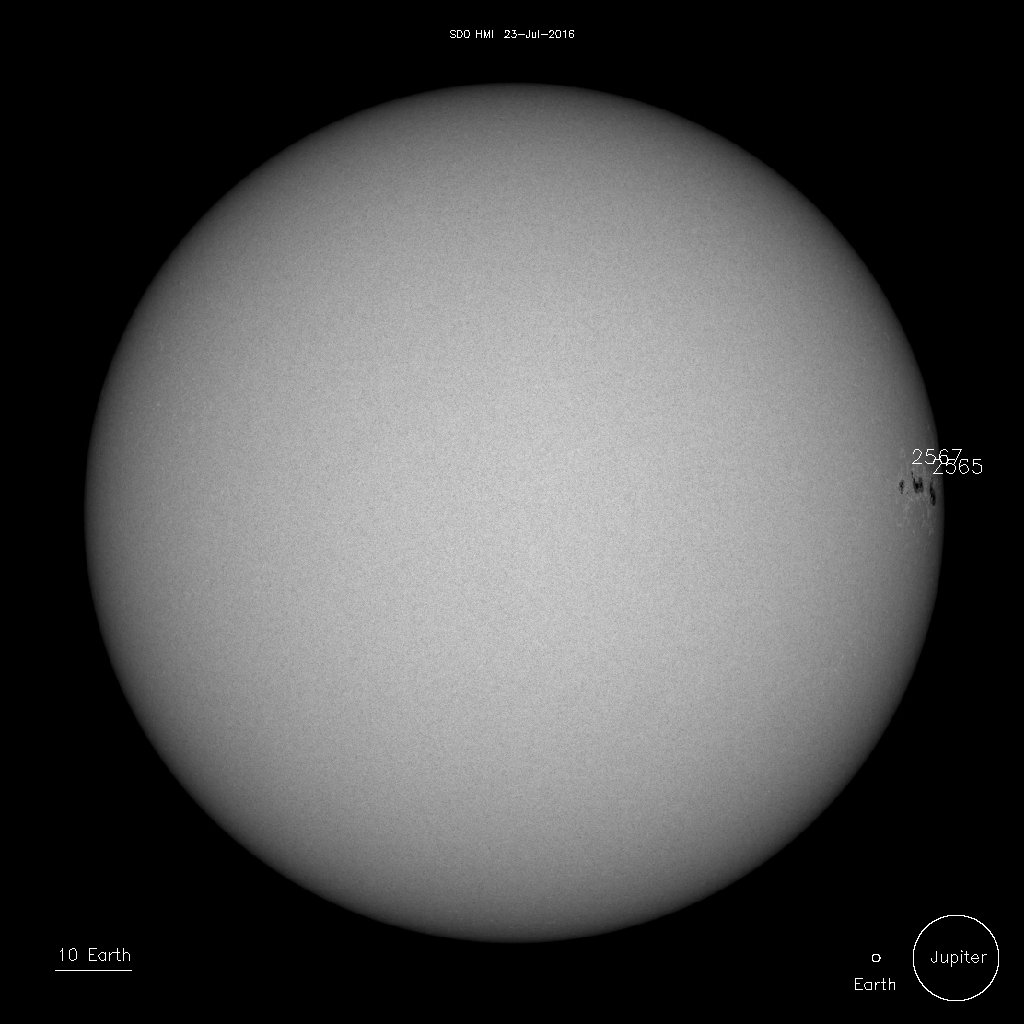

Sunspots on July 23, 2016. Credit: NASA SDO/HMI
2565 – Alpha
2567 – Beta
Forecast
Solar activity is likely to be at low levels with a chance for M-class flares on July 23 and 24. M-class probabilities decrease to a slight chance on July 25 as Regions 2565 and 2567 rotate around the west limb.
The geomagnetic field is expected to be mostly quiet with isolated unsettled periods possible for the next three days (July 23 to 25).
SWPC alerts
Space Weather Message Code: SUMXM5
Serial Number: 144
Issue Time: 2016 Jul 23 0247 UTC
SUMMARY: X-ray Event exceeded M5
Begin Time: 2016 Jul 23 0146 UTC
Maximum Time: 2016 Jul 23 0211 UTC
End Time: 2016 Jul 23 0223 UTC
X-ray Class: M5.0
Location: N04W75
NOAA Scale: R2 – Moderate
NOAA Space Weather Scale descriptions can be found at
www.swpc.noaa.gov/noaa-scales-explanation
Potential Impacts: Area of impact centered primarily on sub-solar point on the sunlit side of Earth.
Radio – Limited blackout of HF (high frequency) radio communication for tens of minutes.
***
Space Weather Message Code: SUMXM5
Serial Number: 145
Issue Time: 2016 Jul 23 0530 UTC
SUMMARY: X-ray Event exceeded M5
Begin Time: 2016 Jul 23 0500 UTC
Maximum Time: 2016 Jul 23 0516 UTC
End Time: 2016 Jul 23 0524 UTC
X-ray Class: M7.6
Optical Class: 2b
Location: N02W73
NOAA Scale: R2 – Moderate
NOAA Space Weather Scale descriptions can be found at
www.swpc.noaa.gov/noaa-scales-explanation
Potential Impacts: Area of impact centered primarily on sub-solar point on the sunlit side of Earth.
Radio – Limited blackout of HF (high frequency) radio communication for tens of minutes.
***
Space Weather Message Code: SUM10R
Serial Number: 685
Issue Time: 2016 Jul 23 0538 UTC
SUMMARY: 10cm Radio Burst
Begin Time: 2016 Jul 23 0510 UTC
Maximum Time: 2016 Jul 23 0510 UTC
End Time: 2016 Jul 23 0515 UTC
Duration: 5 minutes
Peak Flux: 310 sfu
Latest Penticton Noon Flux: 90 sfu
NOAA Space Weather Scale descriptions can be found at
www.swpc.noaa.gov/noaa-scales-explanation
Description: A 10cm radio burst indicates that the electromagnetic burst associated with a solar flare at the 10cm wavelength was double or greater than the initial 10cm radio background. This can be indicative of significant radio noise in association with a solar flare. This noise is generally short-lived but can cause interference for sensitive receivers including radar, GPS, and satellite communications.
***
Space Weather Message Code: SUMXM5
Serial Number: 146
Issue Time: 2016 Jul 23 0554 UTC
SUMMARY: X-ray Event exceeded M5
Begin Time: 2016 Jul 23 0527 UTC
Maximum Time: 2016 Jul 23 0531 UTC
End Time: 2016 Jul 23 0533 UTC
X-ray Class: M5.5
Optical Class: 3b
Location: N02W74
NOAA Scale: R2 – Moderate
NOAA Space Weather Scale descriptions can be found at
www.swpc.noaa.gov/noaa-scales-explanation
Potential Impacts: Area of impact centered primarily on sub-solar point on the sunlit side of Earth.
Radio – Limited blackout of HF (high frequency) radio communication for tens of minutes.
***
Space Weather Message Code: ALTTP2
Serial Number: 1049
Issue Time: 2016 Jul 23 0552 UTC
ALERT: Type II Radio Emission
Begin Time: 2016 Jul 23 0529 UTC
Estimated Velocity: 729 km/s
NOAA Space Weather Scale descriptions can be found at
www.swpc.noaa.gov/noaa-scales-explanation
Description: Type II emissions occur in association with eruptions on the sun and typically indicate a coronal mass ejection is associated with a flare event.
***
Space Weather Message Code: SUM10R
Serial Number: 686
Issue Time: 2016 Jul 23 0552 UTC
SUMMARY: 10cm Radio Burst
Begin Time: 2016 Jul 23 0527 UTC
Maximum Time: 2016 Jul 23 0528 UTC
End Time: 2016 Jul 23 0530 UTC
Duration: 3 minutes
Peak Flux: 900sfu
Latest Penticton Noon Flux: 90 sfu
NOAA Space Weather Scale descriptions can be found at
www.swpc.noaa.gov/noaa-scales-explanation
Description: A 10cm radio burst indicates that the electromagnetic burst associated with a solar flare at the 10cm wavelength was double or greater than the initial 10cm radio background. This can be indicative of significant radio noise in association with a solar flare. This noise is generally short-lived but can cause interference for sensitive receivers including radar, GPS, and satellite communications.
***
Space Weather Message Code: ALTTP4
Serial Number: 530
Issue Time: 2016 Jul 23 0552 UTC
ALERT: Type IV Radio Emission
Begin Time: 2016 Jul 23 0529 UTC
NOAA Space Weather Scale descriptions can be found at
www.swpc.noaa.gov/noaa-scales-explanation
Description: Type IV emissions occur in association with major eruptions on the sun and are typically associated with strong coronal mass ejections and solar radiation storms.
Featured image: M5.5 solar flare producing CME on July 23, 2016. Credit: NASA SDO/AIA 304

Commenting rules and guidelines
We value the thoughts and opinions of our readers and welcome healthy discussions on our website. In order to maintain a respectful and positive community, we ask that all commenters follow these rules.